Lantana: [Cultivation, Care, Irrigation, Substrate, Pests and Diseases]
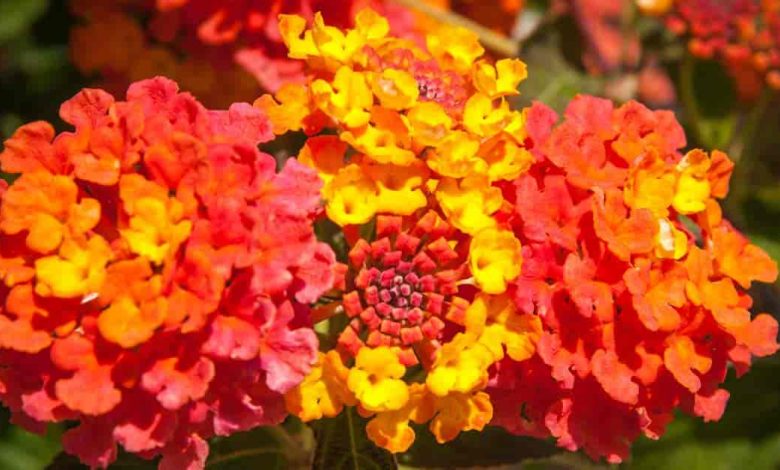
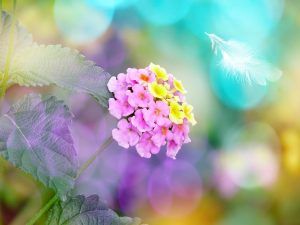 Lantana ((lan-tan-uh)) is a genus of about 150 species of perennial flowering plants in the verbena family, Verbenaceae.
Lantana ((lan-tan-uh)) is a genus of about 150 species of perennial flowering plants in the verbena family, Verbenaceae.
Lantanas are very beautiful flowers, with ornamental value and that usually grow wild.
They are native to tropical America and Africa, but exist as an introduced species in many areas, especially the Australian Pacific region and southern and northeastern India.
The genus includes both herbaceous plants and shrubs growing up to 0.5-2 m tall.
Their common names are bush verbenas or lantanas. The generic name comes from late Latin, where it refers to Viburnum lantana.
Lantana’s aromatic flower clusters (called umbels) are a mix of red, orange, yellow or blue and white flowers. Other colors exist as new varieties are selected.
The flowers often change color as they mature, giving rise to two- or three-color inflorescences.
‘ Wild lantanas’ are plants of the unrelated Abronia genus, usually called ‘sand verbenas’.
Important points when planting Lantana
- Botanical name: Lantana.
- Common Name: Lantana, bush verbena
- Plant type: Perennial in zones 8-10; otherwise annual
- Size: 180 centimeters tall and 250 centimeters wide (like a perennial)
- Sun exposure: Full sun.
- Soil type: well drained.
- Soil pH: Slightly acid.
- Flowering time: All year in frost-free climates.
- Flower color: Mix of red, orange, yellow, blue, white, pink.
- Native areas: Tropical regions of America and Africa.
Characteristics of lantana
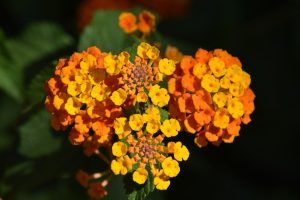 Some species are invasive and are considered noxious weeds, such as in South Asia, South Africa, and Australia.
Some species are invasive and are considered noxious weeds, such as in South Asia, South Africa, and Australia.
In the United States, lantanas are naturalized in the Southeast, especially in the coastal regions of the Carolinas, Georgia, Florida, and the Gulf Coast.
The spread of lantana is aided by the fact that its leaves are poisonous to most animals and are therefore avoided by herbivores, while its fruit is a delicacy for many birds, including the white-fronted eye. yellow of Vanuatu, the magnificent burrowing fairy in Australia, the scaly-breasted munia and the bulbul of Mauritius in the Mascarenes.
The birds distribute the seeds and thus unknowingly contribute to the degradation of their domestic ecosystem.
Biological control of introduced lanthanums has been attempted without success.
In Australia, some 30 insects have been introduced in an attempt to control the spread of lantanas, causing problems of their own.
The lantana bug (Aconophora compressa), for example, is a polyphagous species introduced in 1995 that feeds on dozens of plants, and has not only failed to have a noticeable impact on the lantana population, but has even become a pest in horticulture, parasitizing the related violin woods (Citharexylum).
Small lantana-eating moths, Epinotia lantana and Lantanophaga pusillidactyla, while not pests, have failed to slow the spread of the invasive weed, as has the lantana scrub-hairstreak butterfly (Strymon bazochii) that introduced to control lantanas in the Hawaiian Islands.
Varieties and types of lantanas
 Varieties can grow short or grow slightly taller like a bush.
Varieties can grow short or grow slightly taller like a bush.
Some of the common shades are red, white, blue, yellow, orange, and even blue, but many plants feature flowers that change shades as the season progresses.
Let’s take a look at some of the most popular strains and their characteristics:
- Lantana camara: Also known as Bandera Española, this is the most widely available variety of lantana. In fact, when aplantis simply labeled «Common Lantana», it is most likely acamera.
- Lantana montevidensis: This variety is often referred to as creeping lantana or bush verbena. It comes in many different colors and can bloom all year long in tropical climates. It is often usedornamentallyin flower gardens.
- Lantana depressa:The name says it all for this variation, which spreads like a ground cover and features small, colorful flowers.
- Lantana strigose:The rough bush gets its name from its»hairy»leavesThe flowers, however, are identical to those found on common Lantana varieties.
- Lantana involves: This variety loves thetropicsand can also be called buttonwood or wild sage due to its fragrance.
Lantana is considered a perennial plant in tropical regions of the world, but it also grows quite a bit as an annual. The plants thrive in the southeastern part of the United States, but can also be found in Ecuador, Madagascar, and the Galapagos Islands. They are so prolific in Australia that they are considered an invasive species and efforts are made to control their growth.
Where to plant lantana?
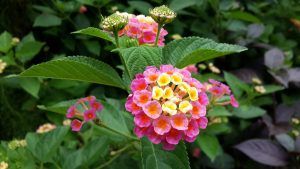 In the coldest regions it is annual; in the warmer ones it can flower all year round.
In the coldest regions it is annual; in the warmer ones it can flower all year round.
It is also commonly used as a houseplant thanks to its long flowering period and bright, cheery colors.
If the plant is potted on the patio during the summer, it should be brought indoors when temperatures drop to about 50 degrees.
Sun exposure
Lantanas like bright sunlight for at least six hours a day to support their profuse blooms.
However, while they can be grown in full sun, they do appreciate some afternoon shade, so try to plant them in locations where they will receive a few hours of partial sun.
Weather
Lantanas arrive at home and garden stores usually in early spring before blooming.
Once they have flowered, the blooming should last until at least early fall.
How do we prepare the land?
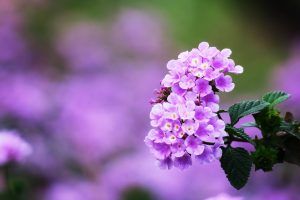 Lantanas grow best in moist, well-drained soil that is slightly acidic, but they can survive in drier conditions.
Lantanas grow best in moist, well-drained soil that is slightly acidic, but they can survive in drier conditions.
Drainage is important as they don’t live as long with wet roots. Lantanas thrive in pots but do need moisture.
If you are going to use lantanas as houseplants, place the pot on a saucer with water and stones for humidity. They are fairly easy to grow indoors as long as they get enough sunlight each day.
Remember to rotate the pot weekly so they don’t start to ‘tip’.
Plant a lantana step by step
- When to Plant: Lantana loves the heat and will do best when planted in late mid-spring, after all danger of frost has passed, after the soil has warmed.
- Where to plant: In a sunny location with fertile, well-drained soil that will remain evenly moist until plants are established.
- Planting in beds and borders: Loosen the soil and put compost. Dig a hole slightly larger than the root ball and position it so that the top of the crown is level with the soil surface. Remove the plant from the container and gently pull out the roots if it is in a pot.
- Place the plant in the hole and fill it in.
- Pack the soil around the base and water well. Mulch coarse organic matter or gravel (keeping it away from the crown of the plant) to suppress weeds and retain moisture.
- Plant in containers: Use a high-quality potting soil and make sure the soil and pots drain well.
- Spaces: Depends on the variety and whether it is grown as an annual or perennial.
To know more, you can see: Lantana cuttings.
lantana care
lantana pruning
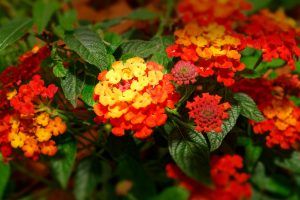 When grown as perennials, the plants become woody shrubs or groundcovers.
When grown as perennials, the plants become woody shrubs or groundcovers.
In spring, cut off dead wood and prune one-third to encourage new growth.
As an annual, prune lightly to shape as needed or if it outgrows a space. Pinch the tips of the stems to encourage branching and flower production.
Some require dry pruning to encourage new flower formation and prevent berry formation.
They also do not require the removal of the thorns to continue flowering, although doing so will not harm them.
wintering
In cooler climates, the plants can overwinter indoors in a cool room or basement.
In marginal regions, some varieties can winter in the ground. Cover with several inches of fallen leaves or other organic matter to insulate the roots after the plants die back in the fall.
Soil
Lantana is tolerant of most soil types, but prefers rich, well-drained, slightly acidic soil. Cover with pine needle mulch to increase the acidity of the soil.
Fertilizer
It is not necessary to fertilize established plants, but a light dose of all-purpose fertilizer can be applied in spring. Too much fertilizer can actually reduce the number of flowers.
To water
Water regularly until plants are established. Mature specimens prefer less water and are fairly drought tolerant. Water once or twice a week in dry or extremely hot climates, especially if grown in containers.
Ornamental value of lantana
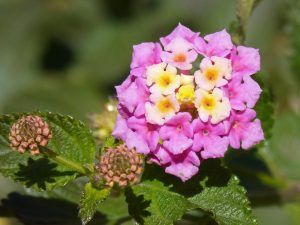 It is an extremely popular genus for garden plants.
It is an extremely popular genus for garden plants.
You can plant the shorter-growing versions along paths, on ledges, or near riverbanks. Trailing varieties, in particular, are ideal container plants, especially when paired with the bright green of the sweet potato vine.
Shrub varieties, which grow taller, can be used throughout a landscape design where foliage and prolific bursts of brilliant color are needed. They fill a corner well, but they also get on well with most other garden plants.
This involves starting a bushy lantana variety in the spring and carefully pruning it back as new shoots appear.
The stem should be supported with a bamboo stick until the plant is strong enough to stand on its own. With timely pruning and transplanting, a tree -like form will appear, and the plant can flower continuously if brought indoors from fall.
Pests and diseases of lantana
pests
There is a common belief that the leaves of lantanas are poisonous to many herbivores, but there are some species of birds that consider them quite tasty.
To prevent these birds from feasting on the plants, a plymouth bird netting system can be implemented to protect the plants from being harvested. It is believed that its rampant growth in Australia could be because some animals find its taste horrible.
They could also be dangerous to pets if they regularly feed on them. Careful with this.
Diseases
Although hardy, the Lantana genus has its share of natural threats.
Insects such as lacewings or whiteflies can attack the leaves, causing them to turn black. There are also some molds that can make their home on lantanas, including powdery mildew, or sooty mold.
These, along with insect problems, can be treated with chemical sprays formulated for plants.

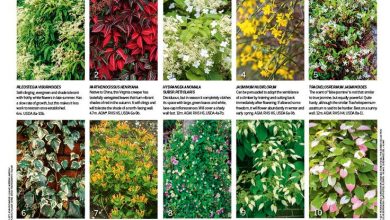

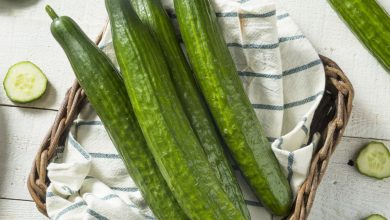
![Photo of Permaculture: [Concept, Principles, Origins and History]](https://www.complete-gardening.com/wp-content/uploads/2022/08/permaculture-concept-principles-origins-and-history.gif)